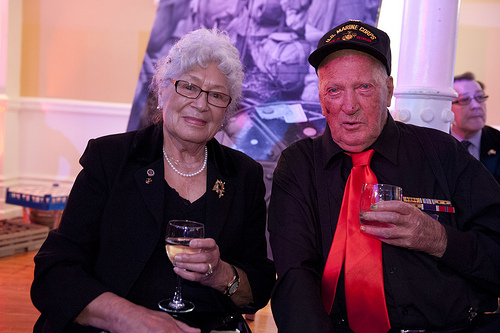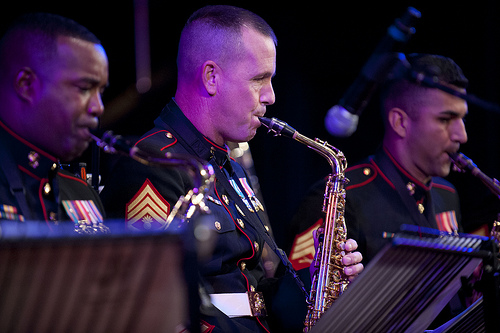Last Monday night we welcomed more than 500 guests to Wellington’s historic Town Hall to celebrate both the 236th Independence Day of the United States of America and the 70th anniversary of the arrival of American armed forces to help defend New Zealand and repel the invaders after the outbreak of World War II in the Pacific. It was a wonderful evening filled with music, conversation, dance, shared memories, and warm appreciation for ongoing friendship and collaboration.
Because the reception was scheduled for the eve of the precise day that American forces first landed at Waitemata harbor in Auckland 70 years ago, we themed the event for June 1942. The hall was decorated with huge posters of American servicemen and the Kiwis who welcomed them, as well as an actual 1940′s American jeep parked in the middle of the floor for guests to inspect or climb into for photographs.
A video reel comprising movie clips, news footage, cabaret footage, photographs, and music from June 1942 played on a big screen above the stage throughout the evening. A troupe from the New Zealand School of Dance performed an excerpt from Paul Taylor’s Company B in period dress. And, in a highlight of the evening, the U.S. Marine Corps Forces Pacific Band took the stage to play big band classics including Benny Goodman’s Sing Sing Sing and Glenn Miller’s In the Mood and Pennsylvania 6-5000.

The U.S. Marine Corps Forces Pacific Band, under an image of forebears playing in Majestic Cabaret in Wellington in 1942.
Our guests included friends from academic, NGO, cultural, faith, business, medical, legal, media, and diplomatic circles as well as a large number of students and military veterans. I had a bit of difficulty navigating the crowd, but I saw Te Papa CEO Michael Houlihan, composer/performer Gareth Farr, philanthropist David Carson-Parker, music archaeologist Jeremy Commons, Opera Chair David Gascoigne, Film Commission Chair Patsy Reddy, Royal NZ Ballet GM Amanda Skoog, Portrait Gallery Director Avenal McKinnon, political tweeps David Farrar and Jordan Carter, Federated Farmers CEO Connor English, Recording Industry Association of NZ CEO Chris Caddick, breakfast impresario Peter Cullen, Chris Laidlaw of Radio NZ, and dancer (and famous mum) Deirdre Tarrant, among others.
From the public service sector, attendees included Speaker of the House Dr. Rt. Hon. Lockwood Smith, Minister Gerry Brownlee, Minister Judith Collins, Minister Paula Bennett, Minister Murray McCully, Minister Dr. Jonathan Coleman, Minister Chris Tremain, Minister Jo Goodhew, NZ First Leader Rt. Hon. Winston Peters, Wellington Mayor Celia Wade-Brown, Kapiti Mayor Jenny Rowan, Hutt City Mayor Ray Wallace, Carterton Mayor Ron Mark, Wellington Deputy Mayor Ian McKinnon, and a couple dozen Members of Parliament from the Labour, Green, New Zealand First, and National parties. Also well represented were the various branches of the NZ Defence Force and retired public servants including my good friend the Hon. Robert Talbot.
Conversation and good cheer were facilitated by a selection of fine California wines and four whiskey tasting stations featuring the libations of Jack Daniels, Jim Beam, Wild Turkey, and McKenna (from straight bourbon to unique kiwi-lime whiskey cocktails, as one wished). For the designated drivers there were Coca Cola products. Food included rice paper rolls with soy lime dip, honey & hazelnut pumpkin bites, duck confit pancakes, Hawkes Bay lamb on candied tomato, and other American and Kiwi favorites.
After an hour of mingling and conversation the formal program started with the presentation of the colors by a detachment of U.S. Marines, followed by the two national anthems. The Star-Spangled Banner was sung by U.S. Marine CWO3 Michael J. Smith, accompanied by the Marine Band. God Defend New Zealand was sung by Royal New Zealand Air Force Sgt. Allan Wright, also accompanied by the Marine Band.
Foreign Minister Murray McCully and I then offered remarks on the long history of service, sacrifice, and friendship shared by our two countries. The highlight of the Minister’s speech was a pithy review of the deepening and broadening of the already strong bilateral relationship over the past several years. For my part, I was pleased to share a quote that I think perfectly sums up the events we were commemorating. As the great American philosopher Oprah Winfrey said, “Everyone wants to ride with you in the limo, but what you want is someone who will take the bus with you when the limo breaks down.”
As usual, Oprah nailed it. The essence of friendship isn’t trade, or commerce, or an unrealistic desire for perpetual harmony. There aren’t epic poems or requiem masses written to Gross Domestic Product, and even the best of friends and closest of spouses disagree with great regularity, and often vehemence. It’s only natural. The marks of true friendship are shared core values … common aspirations … and jumping to help each other when the need — and cost — is greatest.
To return to Oprah’s rubric, in the first half of 1942 the limo didn’t just break down. It was bombed to bits, as was the bus. So Kiwis and Americans walked shoulder-to-shoulder into hell to try to sort things out and help others … because that’s what Kiwis and Americans do. The sentiment might seem quaint to some these days, but great generations take responsibility and act. Even when doing so is uncomfortable, dangerous, costly, or unpopular.
For that reason, the emotional highpoint of the evening was when the Minister and I welcomed onto the stage to join us in the traditional national day toast two very special guests, World War II veterans Claude Bohn and Bruce Cunningham. The two servicemen climbed to the stage to loud applause, with photos of themselves taken in 1942 projected on the huge screen behind them.

U.S. Marine veteran Claude Bohn and R.A.F. veteran Bruce Cunningham being acknowledged for their WWII service.
Mr. Bohn is a U.S. Marine who fought as a machine gunner at Guadalcanal and then later at the Battle of Okinawa. He was last in New Zealand in 1943 when he was convalescing in Wellington after being wounded in combat in the South Pacific. He traveled from his home in the United States in order to attend the 70th anniversary, and he spent a busy week at commemorations in Kapiti and Wellington, including last week’s sunset ceremony and reception at Parliament.
Mr. Cunningham is a Lancaster bomber pilot who served with Number Three Group, RAF Bomber Command, based near Cambridge, England. He flew numerous missions at the height of the war in Europe. In 1944 he was shot down over Belgium, captured by the Germans, and sent to a POW camp. After two unsuccessful attempts, he finally escaped and was able to make his way across Europe to return to England. Mr. Cunningham also attended other commemorative events in the Wellington area last week.
As is customary, the official proceedings concluded with toasts to the People and leaders of our two countries. After the toasts, a troupe from the New Zealand School of Dance entertained guests with a vintage dance performed to the Andrew Sisters’ Rum and Coca-Cola.
The Marine maestro then struck up the Band to play additional selections popular in 1942. Some folks danced, and others continued to mingle and chat. To the bemused consternation of our venue hosts, the party ran almost 2 hours past the intended end time. Which I think is the best sign of a great evening.
A lot of hard work and effort went into planning and executing the event. I have sent the appropriate thank-you notes to those involved, but I would like to express special thanks here to our key sponsors and partners without whom the evening would not have been possible …
… Boeing Australia & South Pacific, Christchurch Engine Centre (Pratt & Whitney), Cubic Defence NZ, GE Corporate, Lockheed Martin, Microsoft New Zealand Limited, Motion Picture Association of America, NZFACT, UPS (United Parcel Service), Ceres New Zealand, MagTek, Visa, Distilled Spirits Association of New Zealand (and its CEO Thomas Chin), and of course our friends from Jack Daniels, Jim Beam, Wild Turkey, and McKenna.
Monday was not a one-off event. Dr WcWaine and I have spent the past week on tour with the Marine Band, stopping for formal concerts and spontaneous RSA, pub, and community jam sessions in Paraparaumu, Paekakariki, Poirirua, Kapiti, Carterton, Masterton, Waiouru, Ngaruawahia, and elsewhere.
The tour is intended not only to commemorate the events of 70 years ago but to thank Kiwis for the hospitality, generosity, and warmth with which they received our countrymen and women in the 1940′s. That’s why our schedule is heavily weighted toward towns and districts where American camps were located.
We stopped yesterday evening for a concert at Turangawaewae to thank Kingi Tuheitia, Te Atawhai, and the iwi of Tainui for the extraordinary kindness shown to American servicemen and women by Kingi Korokī and Princess Te Puea Herangi during the war. After the concert Kingi Tuheitia and Te Atawhai honored the full Marine Band with an invitation into the Mahinarangi meeting house for a group photograph.
We have now arrived in Auckland, and I just introduced the Band to more than 1,000 music lovers at the Bruce Mason Centre in Takapuna Beach. Once this concert is over, I’ll head back across the bridge to prepare for tonight’s Independence Day celebration at the Auckland War Memorial Museum. It should be another great evening. Then we pack our bags again and head to Christchurch for concerts and a reception later in the week.
See you soon, somewhere around the country.
![]()
 RSS
RSS























 View my Profile
View my Profile Connect with Wellington
Connect with Wellington Watch our Videos & Subscribe
Watch our Videos & Subscribe Watch our Videos on Vimeo
Watch our Videos on Vimeo Connect on GPlus
Connect on GPlus US Embassy NZ
US Embassy NZ


 Post Entries (RSS)
Post Entries (RSS)

